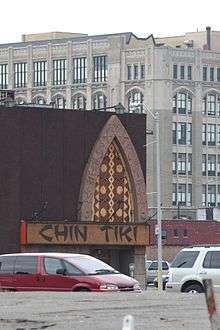Chin Tiki
| Chin Tiki | |
|---|---|
 Chin Tiki, circa 2006 | |
| Restaurant information | |
| Established | 1967 |
| Food type | Polynesian |
| Street address | 2121 Cass Ave |
| City | Detroit, Michigan |
| State | Michigan |
| Country | United States |
| Coordinates | 42°20′10″N 83°3′21″W / 42.33611°N 83.05583°WCoordinates: 42°20′10″N 83°3′21″W / 42.33611°N 83.05583°W |
Chin Tiki was a tiki-themed supper club, nightclub and banquet hall established in 1967 in Detroit, Michigan[1] and closed in 1980, later demolished in 2009.[2] The restaurant was famous for being a film location for Eminem's 8 Mile.
History
Chin Tiki was opened in 1967 by former Ford engineer Marvin Chin.[2] Inspired by the burgeoning Tiki culture fad of the 1950s and 1960s, the first floor restaurant was ornately decorated "with towering tiki statues, waterfalls and a bamboo bridge.".[2] The second floor housed "a spacious nightclub with imitation rock walls and a rattan covered stage."[3] Chin Tiki was said to be frequented by such celebrities as Muhammad Ali, Barbra Streisand and Joe DiMaggio.[1]
Following Detroit's economic downturn, Chin shuttered Chin Tiki in 1980, where it remained untouched for two decades, deemed "a Tiki tomb, a time capsule," by local tiki enthusiasts.[2] The unique look of the building got the attention of production designer Phil Messina, who had Universal Studios contact Chin to contract the use of his facility for the filming of Eminem's 8 Mile.[2]
The renewed interest fueled speculation that the restaurant would reopen however after Chin died in 2006, his family quickly sold the building to Olympia Development LLC, owned by Detroit mogul Mike Ilitch and family. The building was torn down in 2009.[2]
See also
References
- 1 2 Klein, Sarah (2003-09-24). "Freaky over Tiki". Metro Times. Detroit. Retrieved 2017-01-12.
- 1 2 3 4 5 6 Monoghan, John (2009-03-10). "Cass Avenue's exotic Chin Tiki is no more" (PDF). Detroit Free Press. Detroit. Retrieved 2017-01-12.
- ↑ Skrdla, Harry (28 Sep 2006). Ghostly Ruins: America's Forgotten Architecture. Princeton Architectural Press.
